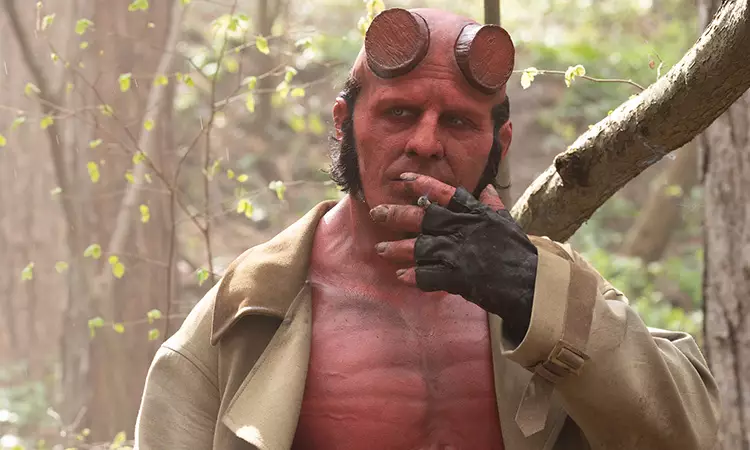The saga of Hellboy has always been a tumultuous one, marked by highs and lows throughout its cinematic journey. From Ron Perlman’s iconic portrayal in Guillermo del Toro’s original film two decades ago, to the sullied reboot featuring David Harbour, fans of the series have witnessed an uneven attempt to reclaim the dark anti-hero’s place in mainstream cinema. However, the latest installment, “Hellboy: The Crooked Man,” directed by Brian Taylor, ventures into darker territory, promising a more authentic take that resonates with the original comic’s essence.
“Hellboy: The Crooked Man” diverges from its predecessors by fully embracing the chilling elements of Mike Mignola’s comic book universe. Set in the rugged backdrop of the Appalachian Mountains in 1959, the film immediately immerses viewers in a bleak and eerie atmosphere. This film doesn’t shy away from its horror roots; disturbing visuals and effective jump scares are strategically placed throughout the narrative, making it distinctly different from prior adaptations. The tonal shift is not merely a superficial change; it instills a sense of foreboding from the outset, promising a gripping experience for horror aficionados.
The integration of procedural storytelling into the film feels reminiscent of reading a serialized comic. “Hellboy: The Crooked Man” unfolds like an episodic adventure, giving it a unique, if not jarring, structure. Emphasizing character development over exposition, the film drops audiences directly into its unfolding mystery, effectively allowing Hellboy and rookie agent Bobbie to act as guides through this bizarre narrative landscape.
The Weight of Lore: A Tale of Witches and Darkness
The plot introduces viewers to a seemingly routine mission gone awry for Hellboy and his partner Bobbie. As they navigate their way through a cursed community beset by witchcraft and the ominous presence of the titular Crooked Man, the stakes grow exponentially. The film skillfully unravels the lore surrounding its characters, revealing the deeply intertwined destinies of Hellboy and the supernatural entities that haunt the town.
This careful crafting shines through as we see an engaging balance of tension and humor, reflective of the original comic series. Rather than relying solely on special effects, the film builds suspense through its plot twists, lending a depth that entices viewers to remain invested. Each revelation about the town’s history and its sinister inhabitants enriches the narrative, showcasing the intricate world Mignola created.
Jack Kesy’s portrayal of Hellboy brings a fresh perspective to the character, albeit with varying results. While he might not possess the same magnetic charm as Perlman or Harbour, his understated performance provides a nuanced take on the complicated anti-hero. Kesy’s delivery of classic one-liners is strategic, allowing audiences to appreciate the character’s complexity rather than earning laughs solely through flamboyance. This representation is, in many ways, a testament to Mignola’s original writing, focusing on the character’s depth instead of outright charisma.
Additionally, the film benefits from the strong acting of Adeline Rudolph as Bobbie, who matches Hellboy’s static nature with her dynamic energy. Their partnership evolves throughout the film, demonstrating the growth of their characters as they confront the horrors of the Crooked Man’s domain. The supporting cast, including Jefferson White as Tom Ferrell, also contributes significantly, enhancing the twisted atmosphere that permeates the film.
Despite its narrative strengths, “Hellboy: The Crooked Man” struggles under financial constraints that hinder its overall presentation. The film occasionally feels more akin to a passion project or a fan film rather than a fully realized Hollywood venture. While it does boast striking visual moments, the lack of a robust budget often leaves CGI looking subpar, detracting from the otherwise accomplished storytelling.
It is a disappointment that the film could not fully realize its potential, especially when juxtaposed with the lavish aesthetics of Del Toro’s earlier works. However, the craftsmanship involved in creating a compelling story cannot be overlooked, as it operates under a different philosophy than prior adaptations. Instead of focusing on a spectacle, this iteration channels its energies into building atmosphere and character engagement.
“Hellboy: The Crooked Man” emerges as a unique and unsettling interpretation within a franchise struggling to leave a lasting mark on contemporary cinema. It harnesses the eerie charm of Mignola’s original work, cuts back on heavy exposition, and relies on a straightforward approach to storytelling. While the production quality may not be on par with expectations, the narrative captures the essence of Hellboy, appealing to die-hard fans while redefining the anti-hero’s place on screen. Whether this film ultimately garners mainstream success remains to be seen, but it undeniably carves out a niche as a worthy adaptation in the realm of horror comics.


Leave a Reply